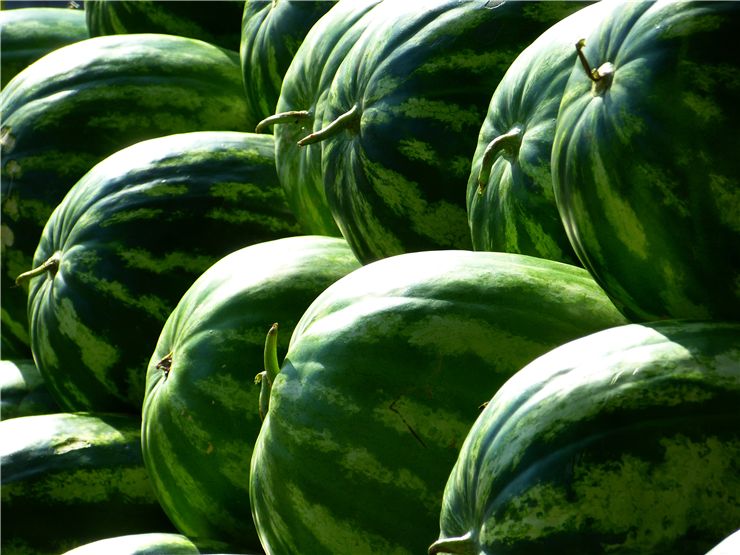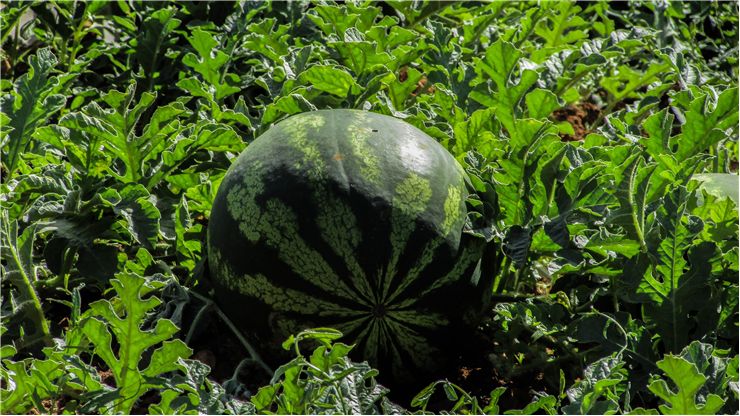History of Watermelon
Watermelon is a flowering plant that is vine-like and whose fruits are not fruits nor vegetables but berries (so-called “pepos”) which are also called watermelons. Berries have an interior which is sweet, juicy and full of water (hence the name) and exterior in a form of smooth hard rind which is green with dark green stripes or yellow spots. Interior can be of different colors (red, pink, orange, yellow, or white) and it contains many seeds (although there are seedless variants). Watermelon is grown annually and can be up to 3 meters long.
The first watermelons appeared in South Africa some 5,000 years ago, and we still can find many wild variants there, from sweet, too bland and bitter. They spread from there and by the 2000th year BC they were cultivated and became an everyday food in ancient Egypt. One of the earliest proofs of that are the hieroglyphs on the buildings from that time that tell stories about the harvesting of watermelons. Remains of watermelons were also found in tombs of the kings where they were left as food for the deceased in the afterlife. Its popularity in the hot, desert regions can be attributed to the high amount of water that watermelon contains. Even Bible mentions watermelon as the food of ancient Israelites who were a slave in Egypt at that time.

From Africa, watermelon crossed to Europe (Moors brought it in the 10th century) where it grew successfully in the warmer parts of Mediterranean. By the 7th century, it reached India and from there China which saw its first watermelons in the 10th century. Today, China is the world's largest producer of watermelons. Rest of Europe didn't state growing watermelons until the 17th century when they were widely accepted as a minor garden crop.
Watermelons were brought to Americas by European colonists and by slave trade from Africa. The first ones were grown in Florida in the 16th century. Later, in the 17th century, they were grown in Massachusetts, Peru, Brazil, Panama and many British and Dutch colonies. Captain James Cook and other explorers introduced watermelons to Hawaii and other Pacific islands.
In time, different types of watermelons developed. They have different shapes, colors (both inside and outside) and characteristics. Because seeds of watermelon are a bit inconvenient while eating, one of the variants is made not to have them. It is developed for the first time in 1939 by treating the un-pollinated flowers of watermelons with an acid. Others are made to be disease-resistant and wilt-resistant. In Japan, people grow cube watermelons. They are grown by placing them into a cube mold made of durable glass, and they grow in the shape of the cube so they can fit into a small refrigerator (Japan has a problem with lack of space for decades now). Some of these practical watermelons reach the price of over $300. Other variants are made to have harder rinds so they could survive longer (and rougher) transportation or are made to be more resilient which makes them suitable for growing in places that don't have a hot climate. There are today over 1,200 variants of watermelon that are grown in more than 96 countries.

As watermelons are 91% water and 6% sugar, they are eaten as dessert, but they are not just sugary sweets. They have high amounts of vitamin C and are low in fat and sodium which makes them healthy food. They can also be turned into juice. Rind of watermelon is also edible but is rarely eaten raw because of its not-so-pleasant taste. It can be stir-fried, stewed and pickled and is sometimes used as a vegetable. Even its seeds can be eaten when they are dried and roasted, or ground into flour.

